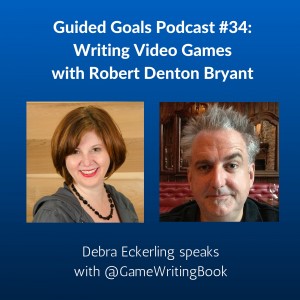 Robert Denton Bryant joins us on the Guided Goals Podcast, and we’re going to talk about writing video games. Robert has worked in Hollywood in both marketing and production, and in video games as both a publisher and a developer. He is author of Slay the Dragon Writing Great Video Games.
Robert Denton Bryant joins us on the Guided Goals Podcast, and we’re going to talk about writing video games. Robert has worked in Hollywood in both marketing and production, and in video games as both a publisher and a developer. He is author of Slay the Dragon Writing Great Video Games.
About Video Games
The reason they wrote the book was to reach writers interested in interactive. Video games are 40 years old, whereas writing thousands of years old, and there’s a skill gap. Robert says they wanted to let writers know “we need you [and] your expertise” and getting into games “is not as hard as you might think.”
The nature of video games is it’s the most immersive medium we have. You can lose yourself in books and movies, but they are finite in length, and they are not interactive. Video games have become a mass medium in the last 15 years, thanks to Facebook and smartphones, Robert adds.
Players Love Games
The interesting thing about players is they will create a world where no world exists. Even Bejeweled is a no-brainer game. It’s natural human behavior to create narrative, where no narrative exists.
Robert references Bill Murray’s creative narrative (whacking weeds and pretending he is on Wide World of Sports) in the movie Caddyshack. It’s very human. We love to make stuff up, when there isn’t stuff already there.
When we talk about game writing is the world-building. You need to bring in elements, so the person joining your world has a good time. World-building is like theme-park building or even party planning. Games are about choice and the player going into your world and curating their own good time, based on what you planned for them.
Choose Your Own Adventure
The way they onboard writers into thinking about interactive they have them do choose-your-own-adventure short stories on the Inklewriter website. Just type in text and design choices – all the code is do automatically behind-the-scenes.
Game designer Sid Meier defines games as a series of interesting choices. Key word is “interesting.”
One of the other exercises he has had students in his class do is take a story they have already writing and bring it into Inklewriter, and make it interactive. It really expands your mind. Create a space and make it true to the world, the tone, and the point of the story. It’s a great first step to diping your toe into interactive writing.
Creating Games
There are many free tools available online that allow you to begin creating a game without having to be a programmer, an engineer, or an artist. You can use clip art, found art, etc., to represent what you want in your game.
The most basic tool, developed by MIT, is called Scratch.
More advanced tools are Game Salad and Game Maker.
With these tools it’s easy to get started designing games.
What’s Next?
If you have a passion project, do your own.
The entry level job is called, content designer. Game writers are also called, narrative designers. It means a writer who understands game design in order to enhance game play.
In games, the writer doesn’t come first. In movies, the writer comes first. With video games, it’s the mechanics: what am I doing on screen, what’s fun. Good games bring writers in early, but they are not the first creator involved.
Once interactive writers understand what they can bring to the table and have worked with some of these tools or map editors or level editors in their favorite games, then they can apply for a job as a content designer, which is basically a quest writer.
You can’t start applying for jobs as a game writer without playing games and understanding games, specifically in the genre you want to work in.
You have to invest the time to learn the medium.
Robert shares the paradigm that became the theme for the class and the book: Aristotle = linear storytelling versus Mario = “I want to play a game!” That’s what makes game writing challenging and rewarding when you get it right!
Work-Life Balance
This is true for anyone who works in front of the computer … step away from the computer, go outside your house, and look at things. Get out of your head.
Personal Goal of the Week: Go outside and look at things.
Bonus Personal Goal of the Week: Play a video game.
Professional Goal of the Week: Try out Inklewriter with a new story or a previously written one.
Want to learn more about writing video games? Listen to the entire interview on iTunes or Stitcher.
Watch the video:
The Guided Goals Podcast gives you the tools, direction, and resources you need to pursue your passion project. Thanks for tuning in.
Subscribe on iTunes, Stitcher or SoundCloud, and leave a review.
* * *
About Debra: A project catalyst, Debra Eckerling works with individuals and small businesses to create a strategy, set goals and manage their projects. Follow Debra @GuidedGoals, Like Guided Goals on Facebook, Subscribe to YouTube.
The Guided Goals Podcast gives you the tools, direction, and resources you need to pursue your passion project. Thanks for tuning in.
Subscribe on iTunes, Stitcher or SoundCloud, and leave a review.
* * *
About Debra: A project catalyst, Debra Eckerling works with individuals and small businesses to create a strategy, set goals and manage their projects. Follow Debra @GuidedGoals, Like Guided Goals on Facebook, Subscribe to YouTube.